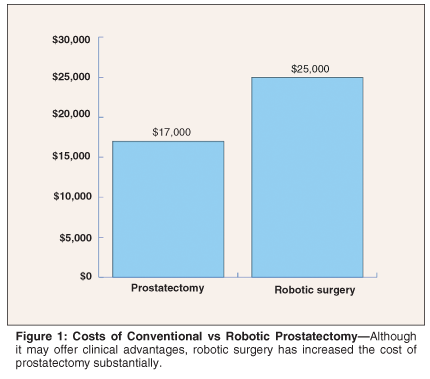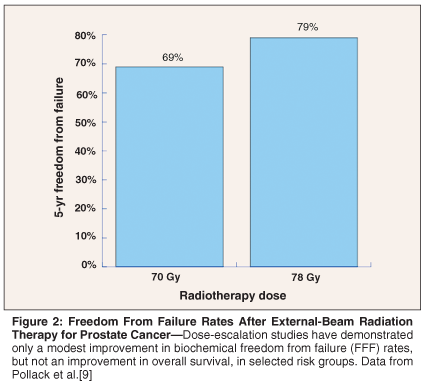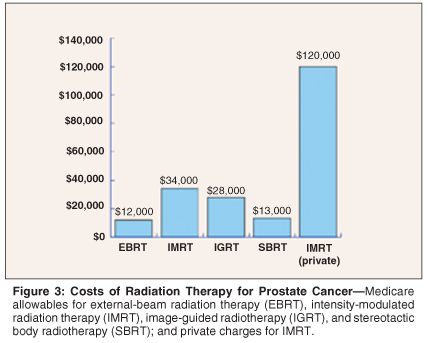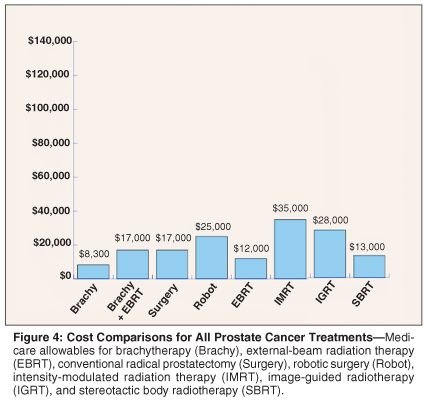Technologic Evolution in the Treatment of Prostate Cancer
past decade has witnessed a host of technologic improvements in prostate cancer therapy. The three major modalities offered in most managed care plans include radical prostatectomy, external-beam radiation therapy (EBRT), and interstitial brachytherapy (seed implant). Continued technologic advancement has led to incremental improvements in the safety and effectiveness of each modality. However, these improvements have led to a significant increase in the cost of treatment.
The past decade has witnessed a host of technologic improvements in prostate cancer therapy. The three major modalities offered in most managed care plans include radical prostatectomy, external-beam radiation therapy (EBRT), and interstitial brachytherapy (seed implant). Continued technologic advancement has led to incremental improvements in the safety and effectiveness of each modality. However, these improvements have led to a significant increase in the cost of treatment.
The past decade has witnessed a host of technologic improvements in prostate cancer therapy. The three major modalities offered in most managed care plans include radical prostatectomy, external-beam radiation therapy (EBRT), and interstitial brachytherapy (seed implant). Continued technologic advancement has led to incremental improvements in the safety and effectiveness of each modality. However, these improvements have led to a significant increase in the cost of treatment.
The different treatment modalities have been variably affected by this cost increase. Robotic tools such as the da Vinci surgical system allow the surgeon to perform a radical prostatectomy with small incisions and unmatched precision. This improvement in technique has been associated with a cost increase compared to traditional open surgery and conventional laparoscopy.[1,2] Intensity-modulated radiation therapy (IMRT) permits more accurate targeting and prostatic dose escalation, while minimizing radiation dose to the bladder and rectum, but with the use of this novel technique, the cost of EBRT has skyrocketed.[1,3,4] Image-guided radiotherapy (IGRT) as well as stereotactic body radiotherapy (SBRT) are other emerging technologies that are also contributing to this increase in cost.
This increased cost of newer treatment modalities has to be weighed against competing interests. Managed care organizations may decide that the increased cost of newer therapies is not justified by the moderate improvements in outcome they produce. While this conclusion may seem reasonable from a societal perspective, it may conflict with the physician's imperative to fully inform patients under his care of the treatments that comprise the current standard of care, regardless of the economic arrangements under which he practices. Failure to offer managed care patients techniques within the standard of care is not only unethical, but may have costly legal ramifications. Practitioners involved in such situations could face legal action by patients who are not cured or who otherwise suffer complications that might have been avoided with newer technology or treatment modalities within the standard of care.
For example, as clinicians at the VA Puget Sound Health Care System and Group Health Cooperative active in the treatment of prostate cancer, we face stark choices in keeping up with technologic change because of the financial constraints inherent in our organizations. Our purpose in writing this article is to summarize current clinical, financial, and legal issues raised by recent technologic improvements. Clinicians and administrators alike must navigate a course that maintains a defensible standard of care within the confines of a limited budget while confronting the reality of rapidly rising health-care costs.
Radical Prostatectomy
Radical prostatectomy evolved from traditional open to conventional laparoscopic to robotic surgery in the course of 15 years. Both the academic and private urologic communities have embraced robotic surgery. Most centers purchase the robot. Theoretical advantages of this technology include less invasive surgery, less blood loss, quicker hospital discharge, and quicker recovery time, which should translate into less lost wages on the part of the patient. However, comparison of length of hospital stay in one large series revealed no difference between radical retropubic prostatectomy and robot-assisted laparoscopic prostatectomies.[5]
There is also a widely held belief that this technologic breakthrough leads to less incontinence and better potency preservation. For instance, one study asserted that postoperative urinary continence after robot-assisted laparoscopic radical prostatectomy was as high as 90%.[6] In one questionnaire-based analysis of outcomes after robotic radical prostatectomy with or without nerve-sparing and prostatic fascia–sparing techniques, investigators reported that 97% of the patients who underwent this procedure could have an erection adequate for intercourse, compared to 74% of the patients who underwent conventional open prostatectomy.[7] These percentages for robotic surgery are favorable; however, randomized comparisons of outcomes between robot-assisted vs conventional radical prostatectomies have not been performed.
As robotic surgery becomes standard in the community, hospital administrators will have increasing difficulty attracting oncologic surgeons if the robotic tools are unavailable in their facilities. Most importantly, patients themselves are beginning to push for robotic technology due to encouragement from private and public information sources including TV, print advertisements, and the Internet.
Although it may offer some clinical advantages, robotic surgery has increased the cost of prostatectomy substantially. Based on Medicare reimbursement for the year 2007, the total allowable reimbursement for a radical prostatectomy as an inpatient procedure is approximately $17,000.[3,4] In contrast, the robot has a $1 million purchase cost, a $100,000 to $200,000 annual maintenance fee, and approximately $2,000 to $3,000 in disposables per case.[1,8] The costs for the robot increase the cost of prostatectomy from approximately $17,000 to $25,000/patient (Figure 1).

External-Beam Radiation Therapy
External-beam radiation therapy has also undergone a remarkable increase in technologic sophistication. Newer software and hardware have enabled the formulation of complex treatment plans, which improve the therapeutic ratio. Radiation beams can be shaped to accurately target the tumor while sparing normal tissue. IMRT treatment planning allows beam intensities to be changed during dose delivery to match the shape of the prostate from various angles. More recently, IGRT has allowed the use of real-time prostate imaging to verify proper patient set-up during treatment. Setup verification is done with computed tomography (CT) or radiograph monitoring of embedded markers, such as gold seeds placed in the prostate prior to treatment. Other treatment modalities including SBRT with systems such as the CyberKnife are emerging as competing alternatives. The premise of SBRT is that larger doses per fraction can safely increase radiobiologic effectiveness and decrease overall treatment time, so long as built-in tracking systems and algorithms to account for internal organ motion are employed to avoid excessive irradiation of adjacent normal tissues.
However, dose-escalation studies in randomized, controlled settings have demonstrated only a modest improvement in biochemical freedom from failure (FFF) rates, without an improvement in overall survival, in selected risk groups.[9,10] For instance, Pollack et al showed FFF rates of 69% and 79% at 5 years for the 70-Gy and 72-Gy treatment groups, respectively (Figure 2).[9] Kuban et al showed FFF rates of 53% and 55% at 8 years for patients treated with >= 60 Gy but < 70 Gy vs >= 70 Gy, respectively.[10]

In contrast to robotic surgery, better-quality radiation therapy has clearly increased cure rates for patients with prostate cancer. However, IMRT comes at a substantial cost premium due to the increasingly sophisticated hardware and technical skill required for daily therapy delivery. The Medicare allowables for conventional EBRT for prostate cancer total approximately $12,000.[1] In contrast, Medicare allowables for IMRT, IGRT (including helical TomoTherapy), and SBRT (including CyberKnife) are $34,000, $28,000, and $13,000, respectively.[3,4] Interestingly, private charges for IMRT may approach $120,000 per patient (Figure 3).[1]

Given the improvement in cure rates and toxicity profiles with better radiation technology, medical organizations are investing heavily in updating their equipment nationwide. They have little choice but to purchase more technologically advanced equipment to provide standard-of-care treatments such as IMRT for prostate cancer. Failing to do so would place the institution at legal risk anytime a patient treated with outdated equipment was not cured. As in the case of prostatic surgery, managed care organizations will have increasing difficulty attracting radiation oncologists to work with outdated equipment.
Brachytherapy
Transperineal prostate brachytherapy has rapidly gained prominence in the treatment of early-stage prostate cancer. Over the past decade, outcomes analyses have clarified implant quality parameters, leading to high cure rates and lower complication rates.[11-14]
Unlike the case for robotic surgery or EBRT, improvements in prostate brachytherapy have come largely from the experience of the radiation oncologist, who over time is better able to achieve optimal seed placement patterns. The result has been an improvement in outcomes that is substantially dependent on physician experience.[15-23] The ability to minimize rectal complications, especially, has been a long process, which involves learning from the relatively few patients who suffer bleeding, proctitis,[24-29] and the most feared complication of brachytherapy, rectal-urethral fistula, which often requires colostomy and urinary diversion.[30-33]
Although they are imperfect, the correlation between undertreating the prostate and cancer recurrence, and the correlation between overtreating and rectal complications have been well established by multiple investigators. These correlations should be recognized, and techniques must be utilized to avoid both under and overtreatment so that treatment consistent with the standard of care can be delivered. Anything short of this will place practitioners at risk for legal action by patients who are not cured or who suffer excessive complications.[34]
In our clinics, we have now modified our implant procedure to include an intraoperative CT scan to verify and guarantee adequate prostate coverage and to prevent excessive rectal doses. Without this CT scan, there may be a greater risk of either undertreating the prostate or overtreating the rectum. Intraoperative CT scanning is practical in the setting of an intraoperative scanner, or with the use of local anesthesia to allow the patient to get off the procedure table, undergo scanning in a nearby room, and return to the procedure room for dosimetric touch-up based on the CT scan analysis. This additional procedure adds at least 30 minutes to the implant time, but we consider it very helpful to meet increasingly stringent guidelines for an adequate implant in every patient.[17-19]
Based on Medicare reimbursements for the year 2007, the total allowable facilities charge for brachytherapy treatment is approximately $8,300. Implant alone is cost competitive relative to prostatectomy, robotic surgery, conventional EBRT, IMRT, IGRT, or SBRT.[3,4] However, the addition of supplemental EBRT to prostate brachytherapy increases the cost substantially since a simulation is still needed and the number of external treatment sessions is decreased by only 30% (Figure 4).

Managed Care and Prostate Cancer Therapy
A variety of issues face managed care organizations in delivering prostate cancer therapy within the current standard of care.
Cost
For prostate cancer treatment, the increased cost of modern therapy is clearly greatest for external-beam irradiation. New prostatectomy techniques represent the second largest cost increase required in order to keep up with the community standard of care. Increased costs to ensure adequate brachytherapy seed placement can be substantial if intraoperative CT scanners are used, but on the whole, brachytherapy is still less expensive to implement than other radiotherapeutic or surgical modalities.
Personnel
All three modalities for cancer treatment require increased personnel training. The surgical learning curve for a radical prostatectomy is steep. Vickers et al calculated that a man operated on by a surgeon who has performed 250 or more prostatectomies has an absolute risk of recurrence 5 years after surgery that is 7.2% lower than one treated by a surgeon who has performed 10 or fewer procedures.[35] Robotic prostatectomy perhaps calls for the greatest personnel investment, as the skill to perform the surgery requires extensive training, with a learning curve over the first 50 to 100 patients. EBRT delivery requires radiation oncologists, medical physicists, radiation therapists, and dosimetrists to update their skills so that they can safely and competently deliver more complex therapy. Brachytherapy also requires substantial training and experience to achieve increasingly stringent dosimetric parameters.
Managed care organizations may have trouble training and retaining adequately skilled practitioners in each of these disciplines. However, it is in the inerest of managed care organizations to promote and offer continued training to personnel in all these new technologies lest they find their patients clamoring for widely used therapies that their physicians are unable to deliver in a manner consistent with the current standard of care.
Legal Action
For better or worse, legal actions can shape the delivery of health care. Facilities that do not invest in cancer care that is up to standards risk expensive litigation over failure-to-cure or excessive complications. Brachytherapy may be especially prone to such lawsuits because seed placement is accurately recorded on a CT scan and available later for second-guessing by plaintiff attorneys.
Prostate cancer therapy at the prevailing national standard of care across any large managed care system will be costly and labor intensive. Accumulating evidence suggests that current technologies enhance the likelihood of cure, reduce complication risk, and may decrease time spent by the patient in treatment. Patients are aware of the new techniques, and specifically ask for them. Therefore, managed care leaders must decide whether to fund the machinery and personnel for contemporary prostate care internally, or to send patients with prostatic malignancy to outside providers who may operate under a different set of resource constraints and a different payment system. Either course is likely to be expensive.
-Tony S. Quang, MD
-Kent E. Wallner, MD
-Paul R. Herstein, MD
-B. Marie Palo, CCS-P, ROCC
-Joseph B. Walker, BA
-Steven Sutlief, PHD
Disclosures:
The authors have no significant financial interest or other relationship with the manufacturers of any products or providers of any service mentioned in this article.
References:
1. Wallner KM, Merrick G, Blasko J, et al: Cost, in Prostate Brachytherapy Made Complicated, 3rd ed, pp 27.1-27.20, Seattle, SmartMedicine Press, 2007.
2. Mouraviev V, Nosnik I, Sun L, et al: Financial comparative analysis of minimally invasive surgery to open surgery for localized prostate cancer: A single-institution experience. Urology 69:311-314, 2007.
3. Trailblazer Health Enterprises, LLC: Medicare home page. Available at www.trailblazerhealth.com/medicare.aspx. Accessed August 23, 2007.
4. Centers for Medicare and Medicaid Services: CMS programs and information. Available at www.cms.hhs.gov/. Accessed August 23, 2007.
5. Nelson B, Kaufman M, Broughton G, et al: Comparison of length of hospital stay between radical retropubic prostatectomy and robotic assisted laparoscopic prostatectomy. J Urol 177:929-931, 2007.
6. Carlsson S, Nilsson A, Wiklund PN: Postoperative urinary continence after robot-assisted laparoscopic radical prostatectomy. Scand J Urol Nephrol 40:103-107, 2006.
7. Dalkin BL: Re: Potency following robotic radical prostatectomy: A questionnaire based analysis of outcomes after conventional nerve sparing and prostatic fascia sparing techniques. J Urol 175:2367-2368 (incl author reply), 2006.
8. Lotan Y, Cadeddu JA, Gettman MT: The new economics of radical prostatectomy: Cost comparison of open, laparoscopic and robot assisted techniques. J Urol 172:1431-1435, 2004.
9. Pollack A, Zagars GK, Smith LG, et al: Preliminary results of a randomized radiotherapy dose-escalation study comparing 70 Gy with 78 Gy for prostate cancer. J Clin Oncol 18:3904-3911, 2000.
10. Kuban DA, Thames HD, Levy LB, et al: Long-term multi-institutional analysis of stage T1-T2 prostate cancer treated with radiotherapy in the PSA era. Int J Radiat Oncol Biol Phys 57:915-928, 2003.
11. Herstein AW, Wallner K, Merrick G, et al: There is a wide range of predictive dosimetric factors for I-125 and Pd-103 prostate brachytherapy Am J Clin Oncol. In press.
12. Papagikos MA, Deguzman AF, Rossi PJ, et al: Dosimetric quantifiers for low-dose-rate prostate brachytherapy: Is V(100) superior to D(90)? Brachytherapy 4:252-258, 2005.
13. Stock RG, Stone NN, Cesaretti JA, et al: Biologically effective dose values for prostate brachytherapy: Effects on PSA failure and posttreatment biopsy results. Int J Radiat Oncol Biol Phys 64:527-533, 2006.
14. Merrick GS, Wallner KE, Butler WM, et al: Brachytherapy in men aged < or = 54 years with clinically localized prostate cancer. BJU Int 98:324-328, 2006.
15. Wallner KM, Merrick G, Blasko J, et al: Design, in Prostate Brachytherapy Made Complicated, 3rd ed, pp 13.11-13.26. Seattle, SmartMedicine Press, 2007:13.11-13.26.
16. Merrick GS, Butler WM: Modified uniform seed loading for prostate brachytherapy: Rationale, design, and evaluation. Tech Urol 6:78-84, 2000.
17. Wallner K, Roy J, Harrison L: Dosimetry guidelines to minimize urethral and rectal morbidity following transperineal I-125 prostate brachytherapy. Int J Radiat Oncol Biol Phys 32:465-471, 1995.
18. Wallner K, Merrick G, Sutlief S, et al: High-dose regions versus likelihood of cure after prostate brachytherapy. Int J Radiat Oncol Biol Phys 62:170-174, 2005.
19. Merrick GS, Wallner KE, Butler WM: Permanent interstitial brachytherapy for the management of carcinoma of the prostate gland. J Urol 169:1643-1652, 2003.
20. Dattoli M, Wallner K, True L, et al: Long-term prostate cancer control using palladium-103 brachytherapy and external beam radiotherapy in patients with a high likelihood of extracapsular cancer extension. Urology 69:334-337, 2007.
21. Stock RG, Stone NN, Tabert A, et al: A dose-response study for I-125 prostate implants. Int J Radiat Oncol Biol Phys 41:101-108, 1998.
22. Herstein A, Wallner K, Merrick G, et al: I-125 versus Pd-103 for low-risk prostate cancer: Long-term morbidity outcomes from a prospective randomized multicenter controlled trial. Cancer J 11:385-389, 2005.
23. Wallner K, Merrick G, True L, et al: 20 Gy versus 44 Gy supplemental beam radiation with Pd-103 prostate brachytherapy: Preliminary biochemical outcomes from a prospective randomized multi-center trial. Radiother Oncol 75:307-310, 2005.
24. Mueller A, Wallner K, Merrick G, et al: Perirectal seeds as a risk factor for prostate brachytherapy-related rectal bleeding. Int J Radiat Oncol Biol Phys 59:1047-1052, 2004.
25. Snyder KM, Stock RG, Hong SM, et al: Defining the risk of developing grade 2 proctitis following 125I prostate brachytherapy using a rectal dose-volume histogram analysis. Int J Radiat Oncol Biol Phys 50:335-341, 2001.
26. Waterman FM, Dicker AP: Probability of late rectal morbidity in 125I prostate brachytherapy. Int J Radiat Oncol Biol Phys 55:342-353, 2003.
27. Han BH, Wallner KE: Dosimetric and radiographic correlates to prostate brachytherapy-related rectal complications. Int J Cancer 96:372-378, 2001.
28. Hilts M, Spadinger I, Keyes M: Comparison of methods for calculating rectal dose after 125I prostate brachytherapy implants. Int J Radiat Oncol Biol Phys 53:775-785, 2002.
29. Sherertz T, Wallner K, Merrick G, et al: Factors predictive of rectal bleeding after 103Pd and supplemental beam radiation for prostate cancer. Brachytherapy 3:130-135, 2004.
30. Tran A, Wallner K, Merrick G, et al: Rectal fistulas after prostate brachytherapy. Int J Radiat Oncol Biol Phys 63:150-154, 2005.
31. Jordan GH, Lynch DF, Warden SS, et al: Major rectal complications following interstitial implantation of 125Iodine for carcinoma of the prostate. J Urol 134:1212-1214, 1985.
32. Theodorescu D, Gillenwater JY, Koutrouvelis PG: Prostatourethral-rectal fistula after prostate brachytherapy. Cancer 89:2085-2091, 2000.
33. Mayadev JW, Wallner K, Merrick G, et al: Prostate brachytherapy-related rectal fistulas: Tracking, analyzing, and preventing a rare complication. Int J Radiat Oncol Biol Phys. In press.
34. Elliott K, Wallner K, Merrick G, et al: Medical malpractice of prostate brachytherapy. Brachytherapy 3:231-236, 2004.
35. Vickers AJ, Bianco FJ, Serio AM, et al: The surgical learning curve for prostate cancer control after radical prostatectomy. J Natl Cancer Inst 99:1171-1177, 2007.
Newsletter
Stay up to date on recent advances in the multidisciplinary approach to cancer.
Navigating Treatment Intensification in Metastatic Hormone-Sensitive Prostate Cancer
A patient case of a 50-year-old man with hormone-sensitive prostate cancer sparked a debate among oncologists regarding the best course of action.